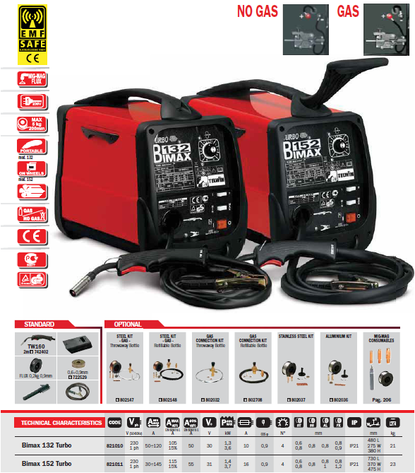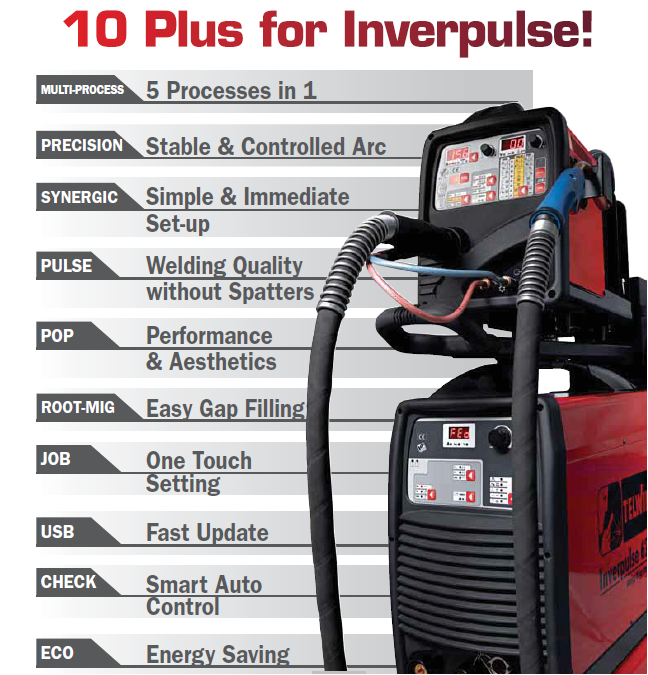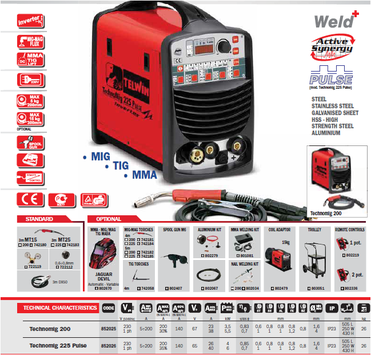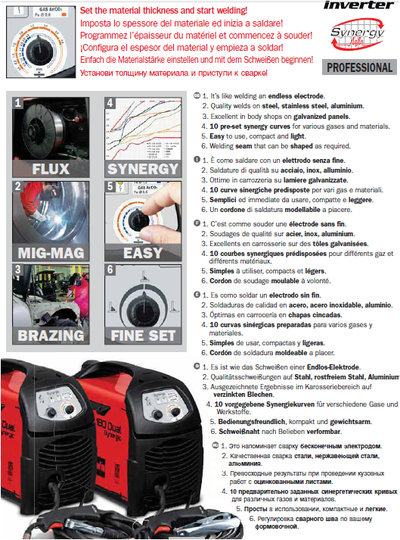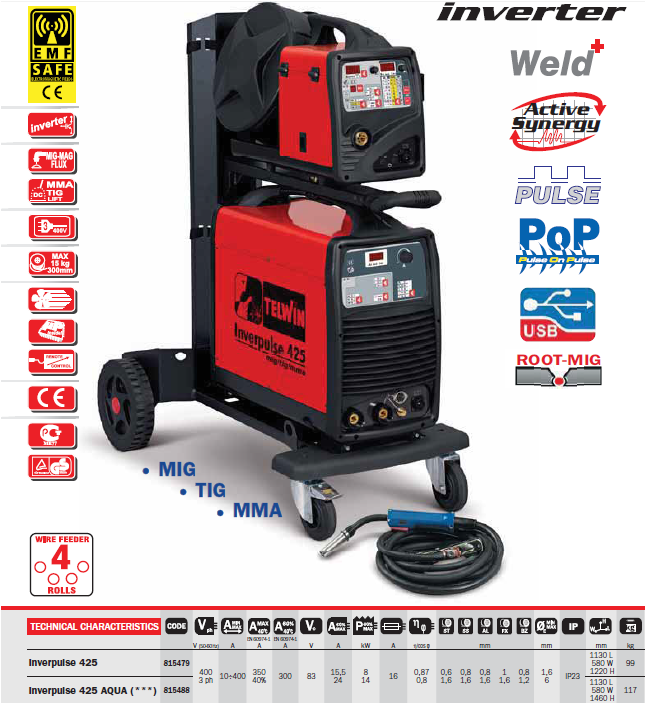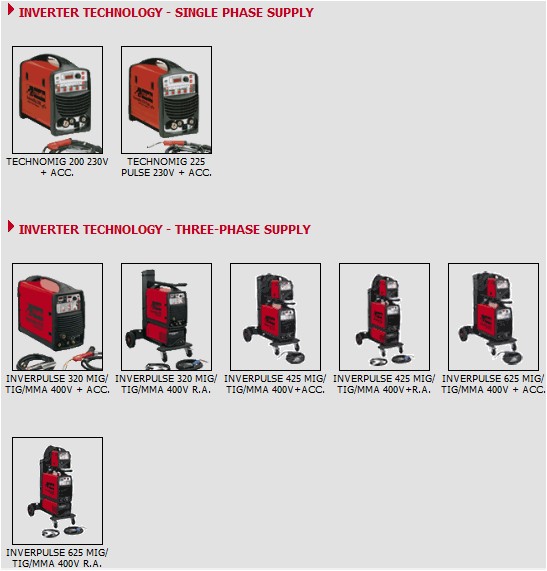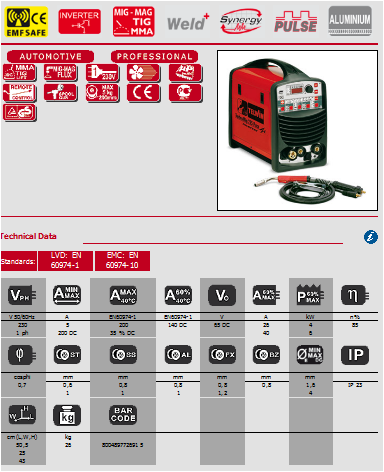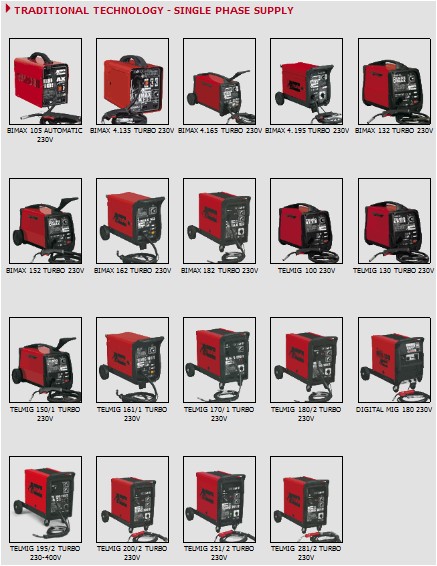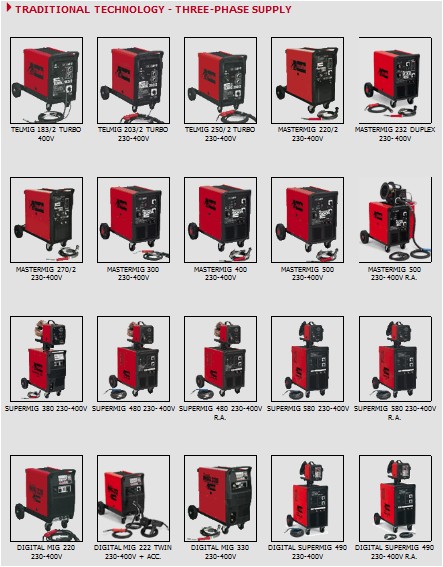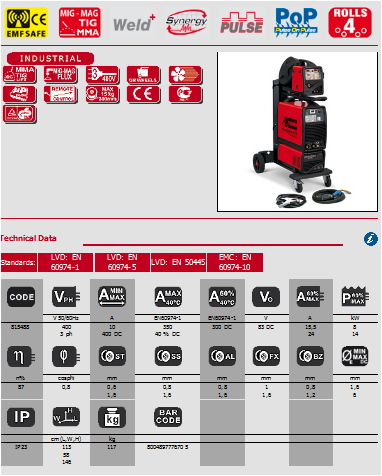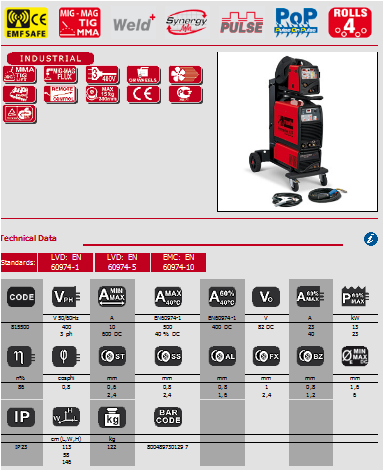ARC WELDING WITH CONTINUOUS WIRE ELECTRODE WITH GAS SHIELD (G.M.A.W.)
WITHOUT GAS SHIELD (FLUX or SELF-SHIELDED WIRE).
Inverter Technology MIG - Single and Three Phase
Traditional Technology MIG- Single Phase
Traditional Technology MIG - Three Phase
ARC WELDING WITH CONTINUOUS WIRE ELECTRODE WITH GAS SHIELD (G.M.A.W.)
OR WITHOUT GAS SHIELD (FLUX or SELF-SHIELDED WIRE)
A. Introduction
Continuous wire welding in a shielded atmosphere is often identified by the abbreviations M.I.G. (Metal Inert Gas) and M.A.G. (Metal Active Gas) or G.M.A.W. (Gas Metal Arc Welding). Continuous wire welding is a process in which the heat required to carry out the weld is supplied by an electric arc that is maintained between the piece to be welded and the wire electrode. The welding zone is constantly fed with the welding material (the wire electrode) by means of a special torch, which also supplies the flow of gas (or gas mixture) whose purpose is to shield the wire electrode, the weld pool, the arc and the area surrounding the base material from atmospheric contamination.The presence in the welding circuit of the gas cylinder (inert or active gas, or a mixture of the two) together with the use of solid wire electrodes, identifies the gas shield welding process (M.I.G. or M.A.G.).
The absence of the gas cylinder from the welding circuit, together with the use of tubular wire electrodes, identifies the welding process without gas shield (SELF SHIELDED WIRE, NO GAS or FLUX); in this case the gas shield is obtained by the action of the flux core contained in the wire.
B. The shield gases
The shield gases used in M.I.G.-M.A.G. welding procedures can be divided into two basic categories: inert and active. Argon, helium and argon-helium mixtures belong to the first type, while carbon dioxide and argon/oxygen or argon/carbon dioxide mixtures are considered active gases.
Argon (Ar) is an inert gas, produced by fractional distillation of the atmosphere. The gas is extracted from the air and may, therefore, contain traces of impurities such as oxygen, nitrogen or water vapour, but it is nevertheless considered suitable for most welding applications.
The use of this gas in M.A.G. applications gives good arc stability and an easy strike. Moreover, given its low thermal conductivity, the central part of the arc column remains at a high temperature giving more fluidity to the drops of material passing through the arc zone.
Helium (He) is an inert, rather rare gas that is scarcely present in the atmosphere and is extracted from underground: it is therefore much more costly than argon.
Compared to argon, helium has a less stable arc but greater penetration; it is mostly used for thick welds and for materials with high thermal conductivity, such as, for example, copper and aluminium.
Since helium, unlike argon, is lighter than air and hence more volatile, a greater quantity of gas is needed to ensure a sufficient shield for the welding zone.
Carbon dioxide (CO2) is an active gas, present in the air and underground. The commonest problem caused by this type of shield is that it can cause the formation of excessive spray and establish an unstable arc; if the arc is kept rather short and of constant length, however, it is possible to keep it under control. With a CO2 shield good penetration is generally obtained.
Active mixtures. It is often possible to take advantage of the qualities of individual gases, by using a mixture for the gas shield e.g. argon-oxygen, argon-oxygen-CO2, argon-CO2.
Even if the inert gases in their pure state are able to perform their shielding effect at any temperature, the addition of active gases improves arc stability and the transfer of the wire electrode metal to the weld pool. This occurs without impairing the shielding effect.
C. Welding wires
The wires can be identified by their chemical composition and also their section morphology, which may either consist of a single metal (solid wires) or have an internal core containing granules (tubular wire).
Particular attention should be paid to the presence of grease or moisture on the surface of the wire electrode, because they could cause cracks, porosity or blowholes; in addition, if the wire electrode reel is not wound uniformly this could cause uneven wire feed resulting in unstable welding.
Solid wires usually have the same composition as the base material, with added elements able to help clean the base material. The most widely used diameters are 0.6 – 0.8 – 0.9 - 1 – 1.2 – 1.6 mm.
Tubular wires, with gas shield, do not consist of solid metal but have an internal core filled with granular powder (flux); this has the same functions as the coating on coated electrodes.
The granular powder or flux can be of rutile, basic or special type.
Compared to solid wires, tubular wires have better arc stability and deeper penetration, ensure a better-looking seam, often eliminating the need for further finishing (e.g. spray grinding) and reducing the risk of defect formation, such as porosity; of course the use of tubular electrodes requires slag removal, as for welding with M.M.A. electrodes.
The most widely used diameters are 0.6 – 0.8 – 0.9 – 1.2 – 1.6 mm.
D. The welding metal: transfer methods
With M.I.G.-M.A.G welding procedures, the method of transferring the welding metal from the wire electrode (either solid or tubular) to the weld pool depends, as well as on the electrical welding parameters, on the wire diameter, the type of power source and the gas used. Depending on these parameters, drop transfer may be by:
1. Immersion (short-arc, dip-transfer or short circuit)
2. Spray-arc
3. Impulse or pulsed-arc
1. immersion transfer (short-arc, dip-transfer or short circuit)
The welding metal is transferred to the weld pool in the form of drops which are immersed in the pool itself, creating continuous short circuits.
This "short arc" transfer is characterised by the presence of current intensities of up to 200 A, by the use of thin solid wires, from 0.6 m to 1.2 mm, enabling thin welds and welding in all positions possible. This is obtained using direct current power sources.
2. spray-arc transfer
This method is designed so that the drops of material are not transferred to the weld pool by contact but rather, due to the effect of the high current, are sprayed into the bath creating a continuous flow of material.
This feature is obtained using direct current power sources when the current used is high (greater than 200 A) and the wires have a diameter of more than 1 mm. A very fluid weld pool is generated, with sizeable penetration, which is suitable for horizontal welding of mainly medium and large thicknesses.
3. pulsed-arc transfer
This procedure can only be obtained with pulsed current power sources. The pulsations actually cause small-sized drops to detach themselves and therefore the typical spray arc is obtained, even with low currents. Heat generation/contribution, pool size and penetration are similar to those achieved with the spray arc method. This procedure is most often used for materials such as aluminium or stainless steel, for which the short arc welding procedure cannot guarantee sufficiently high quality results.
E. Materials welded by M.I.G./M.A.G.
1. mild, carbon steels
Carbon steels are welded with direct current and electrode positive polarity (the wire electrode is connected to the positive pole) using exclusively the M.A.G. welding procedure. Applications may range from the use of CO2 only, to argon - CO2 mixtures in differing proportions (the most common is 80% argon, 20% CO2 ).
The greater the percentage of argon in the mixture the better the properties and arc stability.
The weld has very good properties, especially with short arc where dense/thick weld pools are obtained, allowing welding in all positions.
The use of wires with silicon and manganese content will lead to the elimination of impurities present in the base material and obtain good quality welds.
Bevelled seams should be prepared with thicknesses greater than 3 mm.
2. stainless steels
Stainless steels are welded with direct current and electrode positive polarity (the wire electrode is connected to the positive pole) using exclusively the M.A.G. welding procedure.
The gas shield used should consist of Ar + CO2 or Ar + Oxygen mixtures. The proportion of argon in the mixture should never fall below 98% so as to avoid strong oxidation of the chrome present in the base material.
Seams thicker than 2.5 mm should be bevelled. Care should be taken to choose the most suitable welding material for the quality of the stainless steel being welded.
To achieve a good weld, we advise grinding the spots.
3. aluminium and its alloys
Aluminium and its alloys are welded in direct current or pulsed current with electrode positive polarity (the wire electrode is connected to the positive pole) using the M.A.G. welding procedure.
The gas shield used is usually pure argon. Pure helium or an argon + helium mixture can also be used.
For horizontal welding, irrespective of the thickness, the spray-arc and/or pulsed-arc technique is used; the short-arc technique is used, instead, on thin vertical or corner welds. Given the properties of aluminium, milling the spots instead of grinding is advisable.
4. other materials
The M.I.G.-M.A.G. welding procedure is also used on materials such as nickel and its alloys, copper and its alloys; for all these materials direct current with electrode positive polarity is used.
For welding copper more than 5 mm thick we advise adoption of the M.I.G. procedure but in any case the current intensity should be adjusted according to the welding position and the seam thickness.
OR WITHOUT GAS SHIELD (FLUX or SELF-SHIELDED WIRE)
A. Introduction
Continuous wire welding in a shielded atmosphere is often identified by the abbreviations M.I.G. (Metal Inert Gas) and M.A.G. (Metal Active Gas) or G.M.A.W. (Gas Metal Arc Welding). Continuous wire welding is a process in which the heat required to carry out the weld is supplied by an electric arc that is maintained between the piece to be welded and the wire electrode. The welding zone is constantly fed with the welding material (the wire electrode) by means of a special torch, which also supplies the flow of gas (or gas mixture) whose purpose is to shield the wire electrode, the weld pool, the arc and the area surrounding the base material from atmospheric contamination.The presence in the welding circuit of the gas cylinder (inert or active gas, or a mixture of the two) together with the use of solid wire electrodes, identifies the gas shield welding process (M.I.G. or M.A.G.).
The absence of the gas cylinder from the welding circuit, together with the use of tubular wire electrodes, identifies the welding process without gas shield (SELF SHIELDED WIRE, NO GAS or FLUX); in this case the gas shield is obtained by the action of the flux core contained in the wire.
B. The shield gases
The shield gases used in M.I.G.-M.A.G. welding procedures can be divided into two basic categories: inert and active. Argon, helium and argon-helium mixtures belong to the first type, while carbon dioxide and argon/oxygen or argon/carbon dioxide mixtures are considered active gases.
Argon (Ar) is an inert gas, produced by fractional distillation of the atmosphere. The gas is extracted from the air and may, therefore, contain traces of impurities such as oxygen, nitrogen or water vapour, but it is nevertheless considered suitable for most welding applications.
The use of this gas in M.A.G. applications gives good arc stability and an easy strike. Moreover, given its low thermal conductivity, the central part of the arc column remains at a high temperature giving more fluidity to the drops of material passing through the arc zone.
Helium (He) is an inert, rather rare gas that is scarcely present in the atmosphere and is extracted from underground: it is therefore much more costly than argon.
Compared to argon, helium has a less stable arc but greater penetration; it is mostly used for thick welds and for materials with high thermal conductivity, such as, for example, copper and aluminium.
Since helium, unlike argon, is lighter than air and hence more volatile, a greater quantity of gas is needed to ensure a sufficient shield for the welding zone.
Carbon dioxide (CO2) is an active gas, present in the air and underground. The commonest problem caused by this type of shield is that it can cause the formation of excessive spray and establish an unstable arc; if the arc is kept rather short and of constant length, however, it is possible to keep it under control. With a CO2 shield good penetration is generally obtained.
Active mixtures. It is often possible to take advantage of the qualities of individual gases, by using a mixture for the gas shield e.g. argon-oxygen, argon-oxygen-CO2, argon-CO2.
Even if the inert gases in their pure state are able to perform their shielding effect at any temperature, the addition of active gases improves arc stability and the transfer of the wire electrode metal to the weld pool. This occurs without impairing the shielding effect.
C. Welding wires
The wires can be identified by their chemical composition and also their section morphology, which may either consist of a single metal (solid wires) or have an internal core containing granules (tubular wire).
Particular attention should be paid to the presence of grease or moisture on the surface of the wire electrode, because they could cause cracks, porosity or blowholes; in addition, if the wire electrode reel is not wound uniformly this could cause uneven wire feed resulting in unstable welding.
Solid wires usually have the same composition as the base material, with added elements able to help clean the base material. The most widely used diameters are 0.6 – 0.8 – 0.9 - 1 – 1.2 – 1.6 mm.
Tubular wires, with gas shield, do not consist of solid metal but have an internal core filled with granular powder (flux); this has the same functions as the coating on coated electrodes.
The granular powder or flux can be of rutile, basic or special type.
Compared to solid wires, tubular wires have better arc stability and deeper penetration, ensure a better-looking seam, often eliminating the need for further finishing (e.g. spray grinding) and reducing the risk of defect formation, such as porosity; of course the use of tubular electrodes requires slag removal, as for welding with M.M.A. electrodes.
The most widely used diameters are 0.6 – 0.8 – 0.9 – 1.2 – 1.6 mm.
D. The welding metal: transfer methods
With M.I.G.-M.A.G welding procedures, the method of transferring the welding metal from the wire electrode (either solid or tubular) to the weld pool depends, as well as on the electrical welding parameters, on the wire diameter, the type of power source and the gas used. Depending on these parameters, drop transfer may be by:
1. Immersion (short-arc, dip-transfer or short circuit)
2. Spray-arc
3. Impulse or pulsed-arc
1. immersion transfer (short-arc, dip-transfer or short circuit)
The welding metal is transferred to the weld pool in the form of drops which are immersed in the pool itself, creating continuous short circuits.
This "short arc" transfer is characterised by the presence of current intensities of up to 200 A, by the use of thin solid wires, from 0.6 m to 1.2 mm, enabling thin welds and welding in all positions possible. This is obtained using direct current power sources.
2. spray-arc transfer
This method is designed so that the drops of material are not transferred to the weld pool by contact but rather, due to the effect of the high current, are sprayed into the bath creating a continuous flow of material.
This feature is obtained using direct current power sources when the current used is high (greater than 200 A) and the wires have a diameter of more than 1 mm. A very fluid weld pool is generated, with sizeable penetration, which is suitable for horizontal welding of mainly medium and large thicknesses.
3. pulsed-arc transfer
This procedure can only be obtained with pulsed current power sources. The pulsations actually cause small-sized drops to detach themselves and therefore the typical spray arc is obtained, even with low currents. Heat generation/contribution, pool size and penetration are similar to those achieved with the spray arc method. This procedure is most often used for materials such as aluminium or stainless steel, for which the short arc welding procedure cannot guarantee sufficiently high quality results.
E. Materials welded by M.I.G./M.A.G.
1. mild, carbon steels
Carbon steels are welded with direct current and electrode positive polarity (the wire electrode is connected to the positive pole) using exclusively the M.A.G. welding procedure. Applications may range from the use of CO2 only, to argon - CO2 mixtures in differing proportions (the most common is 80% argon, 20% CO2 ).
The greater the percentage of argon in the mixture the better the properties and arc stability.
The weld has very good properties, especially with short arc where dense/thick weld pools are obtained, allowing welding in all positions.
The use of wires with silicon and manganese content will lead to the elimination of impurities present in the base material and obtain good quality welds.
Bevelled seams should be prepared with thicknesses greater than 3 mm.
2. stainless steels
Stainless steels are welded with direct current and electrode positive polarity (the wire electrode is connected to the positive pole) using exclusively the M.A.G. welding procedure.
The gas shield used should consist of Ar + CO2 or Ar + Oxygen mixtures. The proportion of argon in the mixture should never fall below 98% so as to avoid strong oxidation of the chrome present in the base material.
Seams thicker than 2.5 mm should be bevelled. Care should be taken to choose the most suitable welding material for the quality of the stainless steel being welded.
To achieve a good weld, we advise grinding the spots.
3. aluminium and its alloys
Aluminium and its alloys are welded in direct current or pulsed current with electrode positive polarity (the wire electrode is connected to the positive pole) using the M.A.G. welding procedure.
The gas shield used is usually pure argon. Pure helium or an argon + helium mixture can also be used.
For horizontal welding, irrespective of the thickness, the spray-arc and/or pulsed-arc technique is used; the short-arc technique is used, instead, on thin vertical or corner welds. Given the properties of aluminium, milling the spots instead of grinding is advisable.
4. other materials
The M.I.G.-M.A.G. welding procedure is also used on materials such as nickel and its alloys, copper and its alloys; for all these materials direct current with electrode positive polarity is used.
For welding copper more than 5 mm thick we advise adoption of the M.I.G. procedure but in any case the current intensity should be adjusted according to the welding position and the seam thickness.




